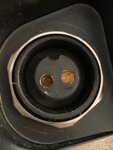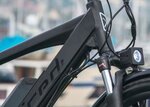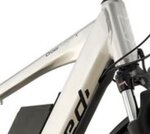I'm just about ready to hang it up with Juiced. While they seem to have good customer support, their quality control seems to be really bad.
My CCX was delivered with a bent rear rack and with the wrong CCS controller firmware ('0' and 'R' modes didn't function correctly). Juiced support was super responsive, and quickly sent out a replacement rear rack and new controller. The new rack looks OK (haven't mounted it yet), but the torque/cadence sensor with the new controller is completely broken (throttle works fine, but pedaling adds no power in any mode, and I rechecked all the connections/cabling). I'm hopeful Juiced will send me out another controller or tell me the magic incantation to make the torque sensor work correctly (still waiting to hear back from them).
Edit 1/12/2019: I'll reply in a new posting with more details and tricks to get the controller installed, but wanted everyone to know that I got the new controller working. In the end I think the new controller worked all along, but my testing methodology was bad. So while I'm not super happy that the bike originally had the rack & controller issues, Juiced support came through very quickly and the new controller they sent me was not defective in any way.
As noted, I got the new controller working, and I think the problem in testing the new controller was my error and not due to any defect in the controller. I do have some guidance for anyone else trying to install a new controller though.
The underlying problem I faced was that I was having some difficulty finishing up the controller install, and decided to try testing the torque/cadence sensor indoors after all the cables were connected, but before everything was buttoned-up (cable ties, routing through the frame, rubber strips in place). To test, I tried lifting the rear wheel, applying some resistance to the wheel with one hand, and pedaling with my other hand. My assumption was that this would be enough force to cause the motor to kick in to test the torque/cadence sensor, but this turned out not to be the case. After playing with it a lot more, and swapping the old controller back in (and finding the same issue), I concluded that I was doing something wrong, and finally found that the motor will only kick in if in the highest gear and pedaling like heck. That was enough to convince me that the controller was probably OK. Edit: to be clear, I did finish putting the bike together and did a quick road test to verify that everything does work.
Now for some suggestions for anyone replacing their controller which are not really mentioned in the installation video or guide:
1. The three rubber strips along the bottom of the downtube that hold the cables inside the frame can be easily removed by just pulling straight out, starting from the bottom-most. However, you will not be able to reinstall by just pushing them in place the same way they came out (unless you have incredibly strong hands). You will also not be able to slide them in from the bottom of the frame if they're dry, as there is just too much friction. What you need to do is spray the edges with a soapy solution and then they will slide in fairly easily from the bottom. This was the major pain point in getting the bike back together. Edit: In retrospect, I'm not sure I absolutely had to remove the rubber strips- perhaps I could have snaked the cables down through the downtube without removing them. I'm not going to take everything apart again to find out ;-)
2. Before attaching the cables to the torque sensor and motor at the rear, and attaching the zip ties, double check the cable routing of the torque sensor, motor, rear brake, and rear derailleur cables to be sure that everything will go back together without too much cable crossover/interference inside the downtube. I probably assembled/disassembled the cables three times before I got it right.
3. Since you'll probably screw up #2 above a few times, get some extra zip ties. Standard 8" ties from the auto parts store are about the right size.
4. The torque sensor and motor cables are about 4 inches too long, and there is no good place to take up the slack. Therefore, you will have to create a loop in each of them that will go inside the downtube. This is a very tight fit, especially for the motor cable which is quite thick. Taking up the right amount of slack also requires that you attach and route the motor/torque sensor cables at the rear wheel first and work backwards toward the controller (thus leading to issues 2 & 3 above).



